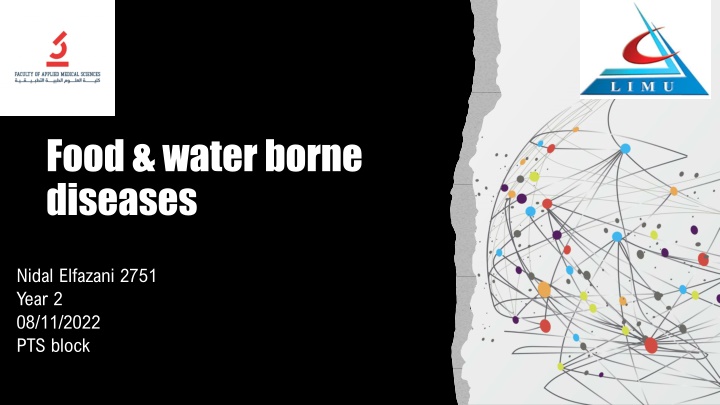
Deadly Food and Water Borne Diseases
Explore the dangers of food and water borne diseases caused by toxic agents, common symptoms, treatment methods, and prevention strategies. Learn about diseases like Norovirus, Salmonella, and E.coli, their impact on health, and crucial steps to safeguard against them.
Download Presentation

Please find below an Image/Link to download the presentation.
The content on the website is provided AS IS for your information and personal use only. It may not be sold, licensed, or shared on other websites without obtaining consent from the author. If you encounter any issues during the download, it is possible that the publisher has removed the file from their server.
You are allowed to download the files provided on this website for personal or commercial use, subject to the condition that they are used lawfully. All files are the property of their respective owners.
The content on the website is provided AS IS for your information and personal use only. It may not be sold, licensed, or shared on other websites without obtaining consent from the author.
E N D
Presentation Transcript
Food & water borne diseases Nidal Elfazani 2751 Year 2 08/11/2022 PTS block
Outline Deadly food and water borne diseases Treatment Prevention List Symptoms Objectives Discuss Epidemiology
Introduction: Why are food and water borne diseases dangerous? Food and water borne diseases are usually caused by toxins produced by toxic bacteria, viruses, and parasites. There are numerous diverse organic, chemical, or radiological agents that when added to food and water can result in numerous distinctive sorts of disorders and diseases. A few can quickly lead to a fatal outcome, while others require to be exposed to long-term to result in serious complications.
Most common food and water borne diseases Norovirus; a highly contagious virus spread via exposure of contaminated water and food, as well as person to person contact. Salmonella; a bacterial disease that affects the intestinal tract. One of the most common pathogens found in food and water. E.coli Infection; a bacterial that spreads after consuming feces contaminated food and water
5 Symptoms Headache, Lethargy,dizziness Mild fever, chills Vomiting, stomach cramps, diarrhea (sometimes bloody), anuria Body aches, weight loss,loss of appetite
6 Image depicting a medical personnel holding a blood sample testing for norovirus Image depicting information regarding salmonella
Norovirus; There is no specific treatment or drug for this virus. It usually just runs its course. But, patients must consume fluids and avoid dehydration, and rest. Salmonella; Antibiotics are used for this type of bacteria. For adults, fluroquinolones is used. And for children, azithromycin is used. Drugs such as loperamide can assist in relieving pain from diarrhea cramps. E.coli infection; Antibiotics such as ciprofloxacin, and levofloxacin are used. Fluid intake and rest are encouraged Treatment
Prevention Hand hygiene Cook meat thoroughly to kill bacteria Always make sure milk and eggs are pasteurized Separate meat, poultry, and seafood from fruits and vegetables Wash vegetables and fruit Disinfect dishes, dishcloths, and cooking area
Epidemiology Annually, approximately six-hundred million cases of norovirus outbreaks are reported to the world health organization. Leading to approximately fifty-thousand deaths, mostly in third world countries
Epidemiology- Continued Globally, there are approximately ninety- three millions cases of salmonella outbreaks each year, with two million reported in the United states alone.
Epidemiology- Continued Each year in the US, there is an estimate of seventy-three hundred cases of E.coli infection from food poisoning per year.
Conclusion Although it is very rare to for salmonella, E.coli or norovirus to be fatal. It can still be dangerous. We must help protect those who are immunocompromised and elderly people by practicing hand hygiene, disinfecting after cooking, as well as cooking meat, poultry and seafood completely to kill ant harmful bacteria
14 References 1. Centers for Disease Control and Prevention. (2022, May 4). Norovirus. Centers for Disease Control and Prevention. Retrieved August 11, 2022, from https://www.cdc.gov/norovirus/index.html 2. K;, M. (n.d.). Norovirus as a foodborne disease hazard. Advances in food and nutrition research. Retrieved August 11, 2022, from https://pubmed.ncbi.nlm.nih.gov/21504820/ 3.Keogh AM;Kellow JE;Koorey DJ;Pritchard RC;Stiel D; (n.d.). Salmonella food poisoning. The Medical journal of Australia. Retrieved August 11, 2022, from https://pubmed.ncbi.nlm.nih.gov/6482757/ 4.JY;, Y. S. C. L. C. H. A. I. A. F. (n.d.). Current pathogenic escherichia coli foodborne outbreak cases and therapy development. Archives of microbiology. Retrieved August 11, 2022, from https://pubmed.ncbi.nlm.nih.gov/28597303/ 5.S;, E. O. J. A. K. J. (n.d.). Salmonella, food safety and food handling practices. Foods (Basel, Switzerland). Retrieved August 11, 2022, from https://pubmed.ncbi.nlm.nih.gov/33919142/
